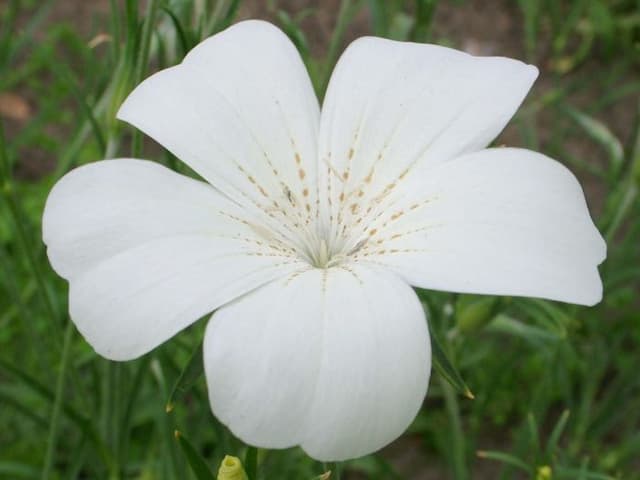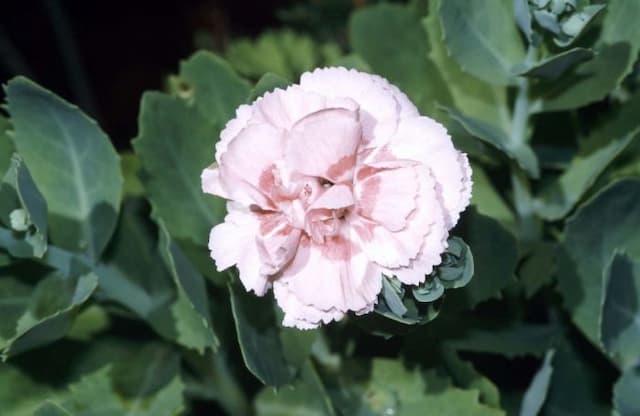Carnation Dianthus 'Riccardo' (b)

ABOUT
The Dianthus 'Riccardo' is a striking perennial plant known for its vibrant bloom color and delightful fragrance. The flowers have a distinct appearance often characterized by a dense cluster of ruffled petals that can be shades of deep pink, often with contrasting rings or markings near the petal's edges. The petals have a frilly or serrated edge, which lends a textured and intriguing look to the blooms. These blossoms are neatly perched atop slender, upright stems that emerge from clumps of narrow, grassy foliage. The leaves are typically bluish-green to gray-green, adding a cool-toned backdrop that makes the bright flowers stand out even more. The plant's foliage is evergreen in some climates, providing year-round interest even when the blooms are not present. The delightful scent of the flowers is reminiscent of cloves or carnations, and it can create a captivating atmosphere in any garden setting where these plants are grown.
About this plant
 Names
NamesFamily
Caryophyllaceae
Synonyms
Pink, Carnation, Sweet William
Common names
Dianthus 'Riccardo'.
 Toxicity
ToxicityTo humans
The plant commonly known as Carnation, when referring to Dianthus 'Riccardo' (b), is not considered highly toxic to humans. However, ingestion of parts of this plant can potentially cause mild gastrointestinal symptoms, such as upset stomach or vomiting. It is uncommon for this plant to cause severe poisoning in humans.
To pets
Carnations, when referring to Dianthus 'Riccardo' (b), are considered to be mildly toxic to pets, such as dogs and cats. Ingestion can lead to mild gastrointestinal discomfort, including mild vomiting or diarrhea. It is not generally known to cause severe toxicity in pets. Owners should still prevent pets from ingesting this plant to avoid any potential discomfort.
 Characteristics
CharacteristicsLife cycle
Perennials
Foliage type
Evergreen
Color of leaves
Green
Flower color
Pink
Height
1 foot 2 inches (35 cm)
Spread
1 foot (30 cm)
Plant type
Herb
Hardiness zones
7
Native area
Europe
Benefits
 General Benefits
General Benefits- Aesthetic Appeal: Dianthus 'Riccardo', commonly known as Carnation, adds vibrant color and beauty to gardens with its bright and varied flower hues.
- Long Bloom Season: Carnations have a lengthy flowering period which lasts from late spring to early autumn, providing a prolonged display of color.
- Fragrance: Carnations are known for their spicy, clove-like fragrance, which can be a delightful addition to any garden or bouquet.
- Attracts Pollinators: These flowers are attractive to pollinators such as bees and butterflies, helping to support local ecosystems.
- Low Maintenance: Carnations are relatively easy to grow and maintain, making them suitable for gardeners of all skill levels.
- Drought Tolerance: Once established, Carnations have good drought tolerance, needing less water than many other garden plants.
- Versatility: Carnations are versatile in use, suitable for flower beds, borders, container gardening, and as cut flowers for indoor decoration.
- Cold Hardiness: Carnations can tolerate cold temperatures and are hardy in many climates, making them a robust choice for many gardens.
 Medical Properties
Medical PropertiesThis plant is not used for medical purposes.
 Air-purifying Qualities
Air-purifying QualitiesThis plant is not specifically known for air purifying qualities.
 Other Uses
Other Uses- Carnation 'Riccardo' leaves can be used as a natural dye for textiles, where they impart a variety of soft colors depending on the mordant used.
- Petals from the Carnation 'Riccardo' may serve as a colorant in cosmetics, such as lip balms and blushes, giving a light, natural pigment.
- Pressed Carnation 'Riccardo' flowers can be incorporated into paper making for decorative purposes, adding a unique and personal touch to handmade papers.
- Carnation 'Riccardo' blossoms can be used as a natural insect repellent when placed among linens and clothes due to their fragrance.
- The edible petals of the Carnation 'Riccardo' can be crystallized with sugar to make elegant edible decorations for cakes and desserts.
- Dried Carnation 'Riccardo' flowers can be included in potpourri to add color and a pleasant fragrance to a room.
- Carnation 'Riccardo' flowers can be floated in a bowl of water as a simple and elegant table centerpiece for events and gatherings.
- Whole Carnation 'Riccardo' blossoms can be used to infuse syrups, giving a sweet floral note to cocktails and desserts.
- The petals of Carnation 'Riccardo' can be scattered in a bath for a fragrant and relaxing experience, enhancing the bathing ritual.
- Carnation 'Riccardo' flowers can be used in crafting, such as making bookmarks or natural wreaths, to bring a touch of nature indoors.
Interesting Facts
 Feng Shui
Feng ShuiThe Carnation is not used in Feng Shui practice.
 Zodiac Sign Compitability
Zodiac Sign CompitabilityThe Carnation is not used in astrology practice.
 Plant Symbolism
Plant Symbolism- Love: Dianthus, often referred to as 'pinks' due to their pinkish hues and frilled edges that resemble clothing pinks (scalloped edges), are commonly associated with love and affection.
- Admiration: Giving someone a dianthus can express deep admiration and gratitude.
- Passion: The bright colors of the Dianthus 'Riccardo' often symbolize passionate emotions.
- Distinction: The unique patterning and fragrance of dianthus flowers can represent someone's distinctive and notably excellent qualities.
- Pure Affection: Some interpretations of the dianthus flower suggest themes of pure and platonic love, free from materialistic intentions or selfish desires.
- Boldness: Dianthus flowers, with their vibrant and pronounced features, can stand for boldness and daring in the face of adversity.
 Water
WaterFor Carnations, you should maintain consistent moisture but avoid overwatering, as this can lead to root rot. Water the plants deeply when the soil feels dry to the touch, about once or twice a week, depending on weather conditions. Typically, during the growing season, Carnations may require around 1 gallon of water per week. During hot, dry spells, you might need to water more frequently to keep the soil evenly moist. Always allow the top inch of soil to dry out before watering again to ensure you're not overwatering.
 Light
LightCarnations thrive in full sun conditions where they can receive at least 6 to 8 hours of direct sunlight a day. The best location for these plants is a spot where early morning sunlight is available, which is less intense and helps to dry dew on the leaves, reducing the risk of fungal diseases. If you're growing Carnations indoors, place them near a south-facing window where they will get plenty of bright, direct sunlight.
 Temperature
TemperatureCarnations prefer cooler temperatures and will flourish in environments where the temperature ranges from 40 to 60 degrees Fahrenheit. They can survive minimum temperatures down into the 20s, but frost can damage the plants, so protection or bringing them indoors may be necessary. The ideal temperature for promoting vigorous growth for Carnations is between 50 and 70 degrees Fahrenheit during the day.
 Pruning
PruningPruning Carnations is important to promote bushy growth, encourage more blooms, and maintain plant health. Trim off the spent flowers regularly to encourage continuous blooming throughout the season. Do a more thorough pruning in early spring to remove any old or dead growth and to shape the plant. The best time for pruning is after the last frost in spring or early when new growth starts to appear.
 Cleaning
CleaningAs needed
 Soil
SoilThe ideal soil mix for Sweet William (Dianthus 'Riccardo') should drain well, yet retain moisture, consisting of a mix of loam, compost, and sharp sand to provide good drainage. The soil pH should range between 6.0 and 7.5.
 Repotting
RepottingSweet William should be repotted every 2 to 3 years to refresh the soil and to accommodate root growth. It’s better to repot in the spring just before the growing season starts.
 Humidity & Misting
Humidity & MistingSweet William thrives best in moderate humidity conditions. Average room humidity is sufficient, avoiding overly dry or humid atmospheres which are not conducive for optimal growth.
 Suitable locations
Suitable locationsIndoor
Provide full sun by a window and well-draining soil.
Outdoor
Place in full sun to partial shade, in fertile, well-drained soil.
Hardiness zone
3-9 USDA
 Life cycle
Life cycleThe Dianthus 'Riccardo', commonly known as 'Riccardo Pinks', begins its life cycle as a seed, which, when sown in fertile, well-draining soil and provided with suitable conditions of light and temperature, will germinate. During the seedling stage, the young plant develops its root system and grows its first set of true leaves, establishing itself in the growing medium. As it enters the vegetative stage, the Dianthus 'Riccardo' continues to grow, producing a lush mound of foliage. The next stage involves flowering where the plant produces the characteristic vibrant pink blooms, often marked by a pleasant fragrance, which can attract pollinators to facilitate cross-pollination. Once pollinated, the flowers develop into seed capsules, containing seeds that complete the reproductive cycle when they mature and are dispersed into the environment. After seed set or in adverse conditions, the plant may enter a period of dormancy, particularly in regions with cold winters, though Dianthus 'Riccardo' is a perennial plant and can regrow from the root system the next growing season.
 Propogation
PropogationPropogation time
Spring-Early Summer
Dianthus 'Riccardo', commonly known as Carnation, is typically propagated through the method of stem cuttings. This popular method allows gardeners to create new plants that are genetically identical to the parent plant. The best time to take stem cuttings for propagation is during late spring or early summer when the plant is actively growing. To propagate Carnations by cuttings, one should select healthy, non-flowering stems and cut a piece that is about 4 to 6 inches long (10 to 15 centimeters) just below a node. Remove the lower leaves, and dip the cut end into a rooting hormone powder for better chances of success. The cutting should then be planted in a well-draining soil mix and kept in a warm, well-lit area, but out of direct sunlight, ensuring the soil stays moist but not waterlogged. Roots typically develop within a few weeks, after which the new Carnation plants can be transplanted to their final location.








![Pink [Bubblegum]](/_next/image?url=https%3A%2F%2Fplants-admin.emdemapps.com%2Fimages%2Fplants%2F%2Fimages%2F604b596f31cbb.png&w=640&q=75)
